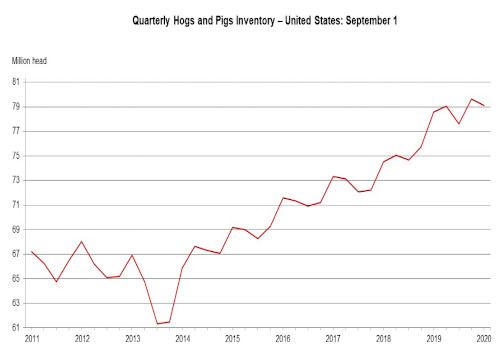The U.S. Department of Agriculture’s National Agricultural Statistics Service (NASS) reports that there were 79.1 million hogs and pigs on U.S. farms as of Sept. 1, 2020, up 1% from September 2019, but down 1% from June 1, 2020, according to the Quarterly Hogs and Pigs report published today.

Other key findings in the report were:
- Of the 79.1 million hogs and pigs, 72.8 million were market hogs, while 6.33 million were kept for breeding.
- Between June and August 2020, 35.1 million pigs were weaned on U.S. farms, down 3% from the same time period one year earlier.
- From June through August 2020, U.S. hog and pig producers weaned an average of 11.04 pigs per litter.
- U.S. hog producers intend to have 3.12 million sows farrow between September and November 2020, and 3.11 million sows farrow between December 2020 and February 2021.
- Iowa hog producers accounted for the largest inventory among the states, at 25.1 million head. North Carolina had the second largest inventory at 9.60 million head. Minnesota was third with 9.20 million head.
To obtain an accurate measurement of the U.S. swine industry, NASS surveyed over 5,000 operators across the nation during the first half of September. Surveyed producers were asked to report their hog and pig inventories as of Sept. 1, 2020 by internet, mail, or telephone.
The Quarterly Hogs and Pigs report and all other NASS reports are available online at www.nass.usda.gov.
Source : usda.gov